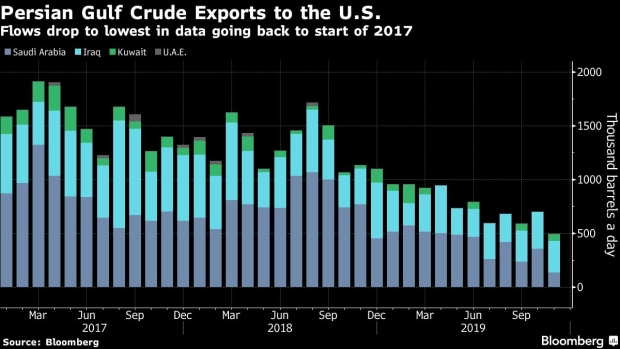Crude supplies from OPEC’s Middle East oil exporters, excluding Iran, fell to their lowest level since July, as the group’s ministers gathered in Vienna to decide the next steps in their pact with a band of non-OPEC countries that aims to limit supply. Bloomberg reports in its article OPEC’s Middle East Oil Flows Shrink as Group Mulls Extended Cuts that Saudi Arabia, Iraq, Kuwait and the United Arab Emirates, which together account for nearly 70% of OPEC’s entire production, shipped an average of 14.79 million barrels a day of crude and condensate in November, tanker-tracking data compiled by Bloomberg show. That was a drop of 970,000 barrels a day from October and the lowest level since July.
Saudi shipments in November dropped back to the levels seen before the attacks on its oil processing facilities in September, falling month on month by 680,000 barrels a day, or 9%, to 6.63 million. Exports from the country’s Yanbu terminal on its Red Sea coast dropped by 23% to 600,000 barrels a day, indicating that the kingdom is not making any real effort to avoid using the Strait of Hormuz for its exports in the wake of the attacks.
Flows from Kuwait also fell in November, dropping by 220,000 barrels a day, or 11%, to their lowest level in tanker tracking data going back to October 2016. The U.A.E. also shipped less crude and condensate last month, with flows falling by 145,000 barrels a day, or 5%.
Iraq’s exports from its Basra Oil Terminal bucked the trend set in the rest of the Persian Gulf, rising month-on-month by 74,000 barrels a day to 3.45 million. Shipments were still more than 200,000 barrels a day below the level seen in September, as the country attempts to stick closer to its output target agreed as part of the OPEC+ deal after the oil minister publicly pledged at an OPEC gathering that month that Iraq would finally honor its commitments.
Observed shipments from Iran have been excluded, as tankers leaving the country often only appear in tracking data several weeks later, once they have reached choke points like the Strait of Malacca or the Suez Canal, making early assessments of flows from the country less reliable. Tracking signals from five tankers carrying an estimated 5.6 million barrels of Iranian crude or condensate appeared during the first half of November in positions that the ships could only have reached if they had left the Persian Gulf in October, raising the country’s observed October shipments to 388,000 barrels a day from an initial estimate of 262,000 barrels.
With more than 36 million barrels of oil on ships from OPEC’s Middle East exporters yet to signal a final destination, estimates of flows to individual countries are subject to revision.
Persian Gulf crude flows to India, the closest major market, fell in November to a three-month low. Shipments from Iraq fell by 164,00 barrels a day to their lowest level since April. That drop was offset by an increase in flows from the U.A.E., which rose month-on-month by 168,000 barrels. With voyage times of only a few days to refineries on India’s west coast, compared to three to four weeks to China, Japan and South Korea, lower flows from the Persian Gulf countries show up quickly in import statistics. India’s October crude imports were down 8.5% year-on-year and Persian Gulf shipment data suggest November’s imports could also be low.
Flows to the U.S. slumped below 500,000 barrels a day in November, although this figure could rise as final destinations become apparent for those tankers whose delivery points remain unclear. A voyage time of about six weeks to both the East and West Coasts of the U.S. means that actual flows often don’t become apparent for several weeks after loading.
Observed shipments from Persian Gulf OPEC countries, excluding Iran, to China, fell by 660,000 barrels a day, although this figure is also subject to upward revision as more destination data become available. Flows from Saudi Arabia fell by more than 500,000 barrels a day and will not catch up with the October number even if all of the ships showing no final destination end up in China.

Shipments in November to Japan fell back after October’s jump, with higher shipments from Saudi Arabia and Iraq more than offset by lower flows from the U.A.E. and Kuwait.
Flows to South Korea, the other big Asian buyer of Persian Gulf crude, rose by 293,000 barrels a day, or 18%, in November to reach their highest level since January. Flows from Iraq more than doubled to 525,000 barrels a day, while shipments from Saudi Arabia rose by 180,000 barrels a day to their highest since June.
Note: The figures above exclude exports from northern Iraq via Ceyhan in Turkey but include outflows from the U.A.E.’s Indian Ocean coast and from Saudi Arabian Red Sea ports. They include crude and condensates, a light form of oil extracted from gas fields. Figures for flows to individual destinations are subject to change, especially when ships pass transit points like Singapore and the Suez Canal.






